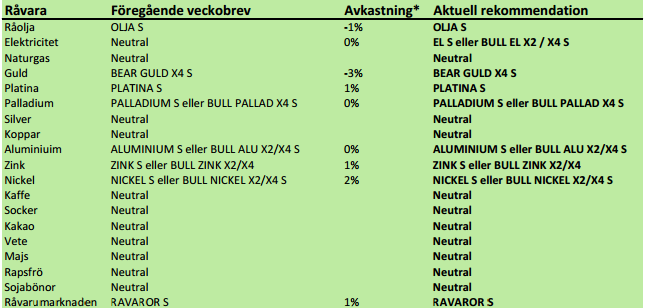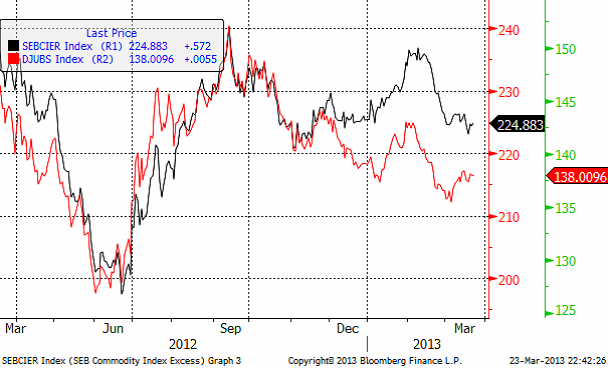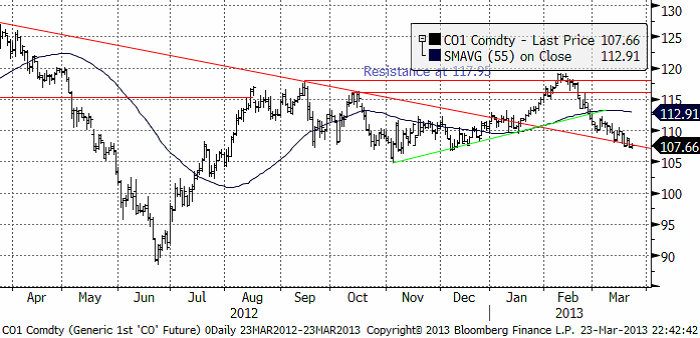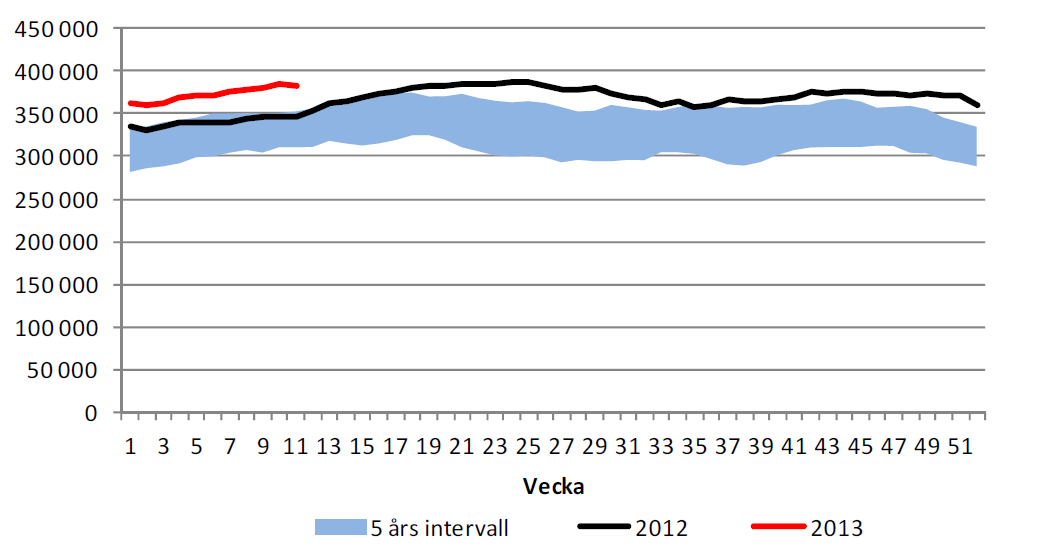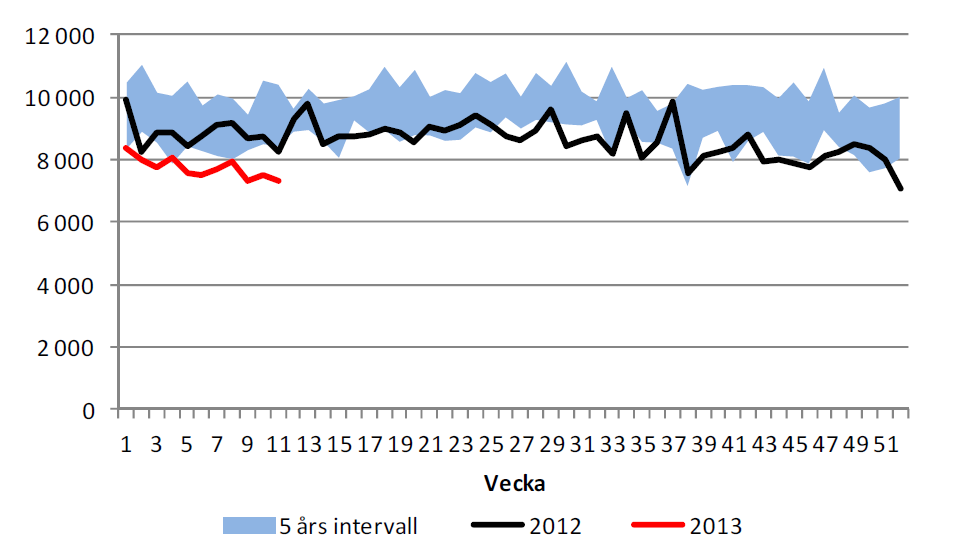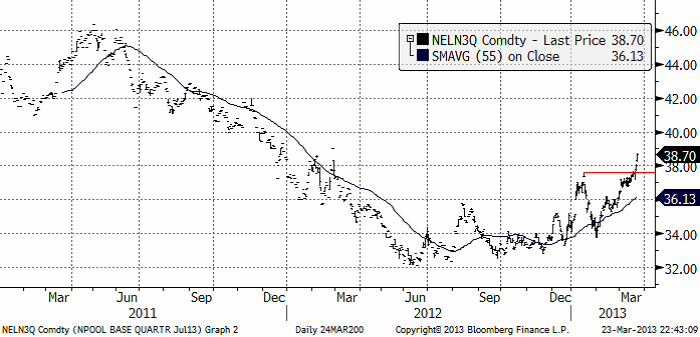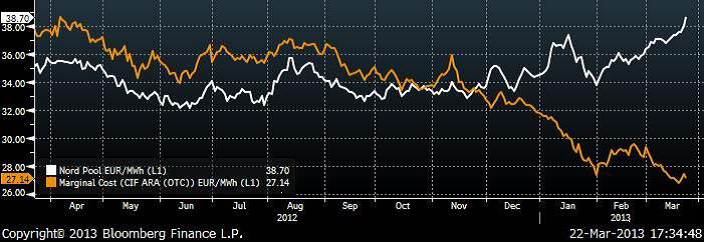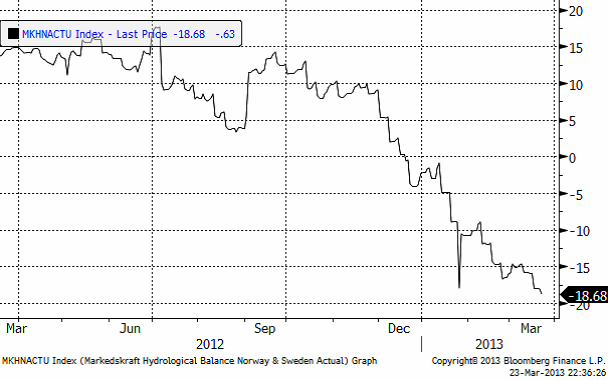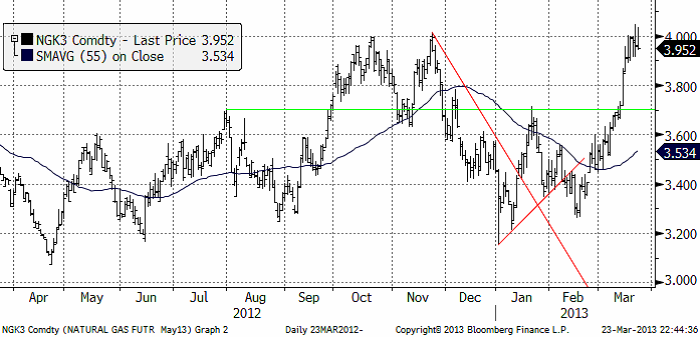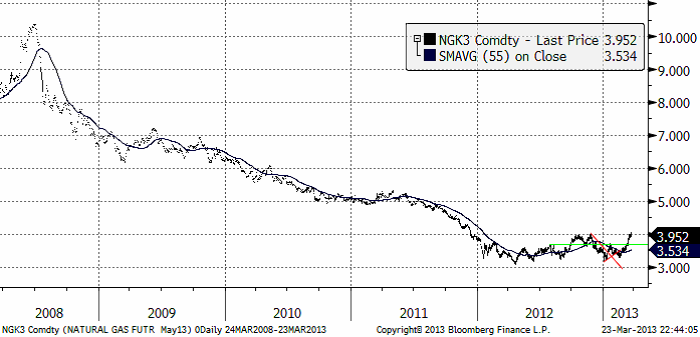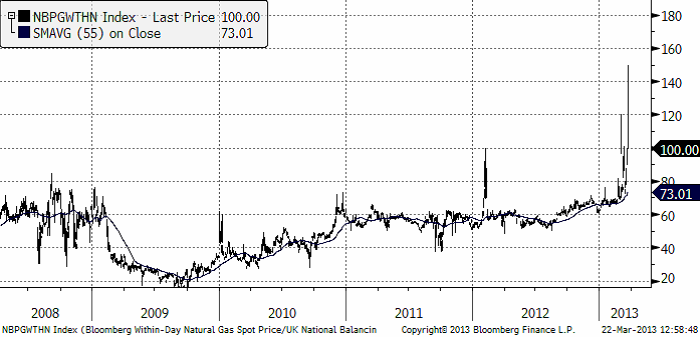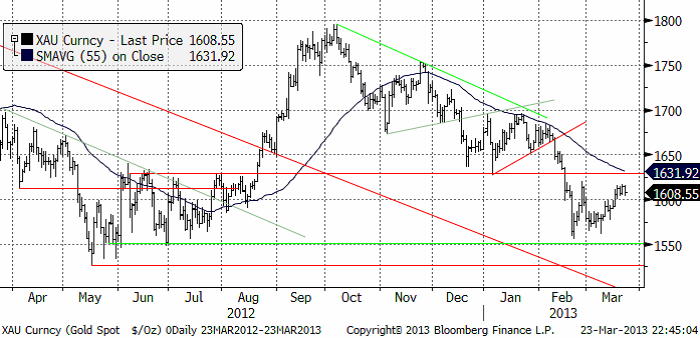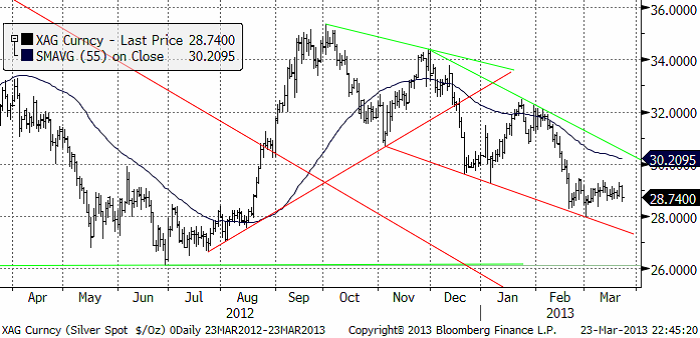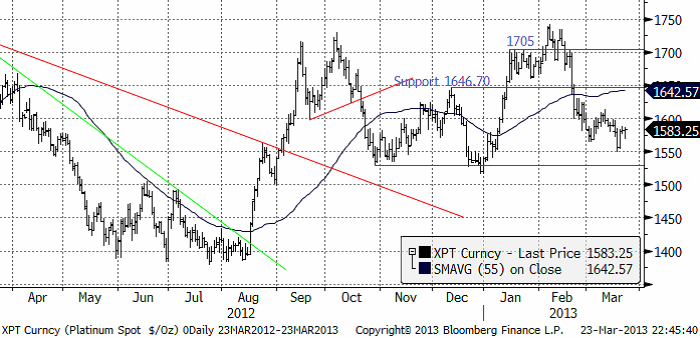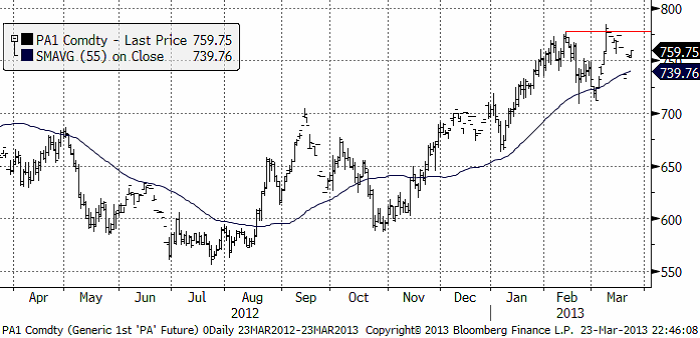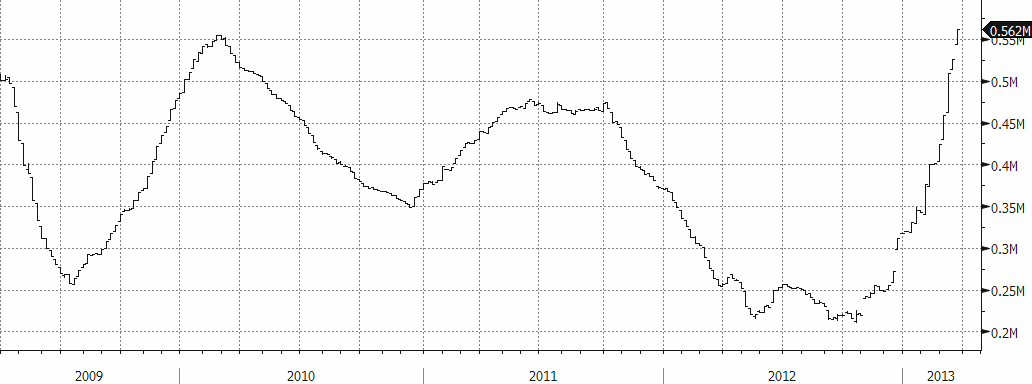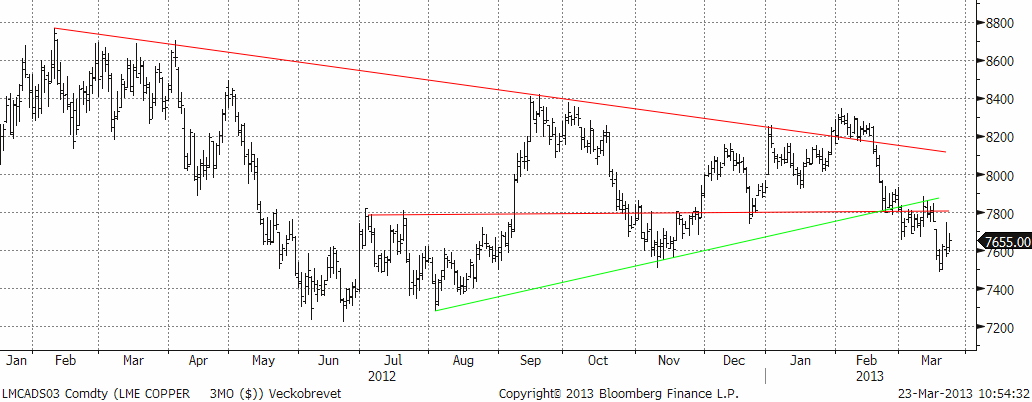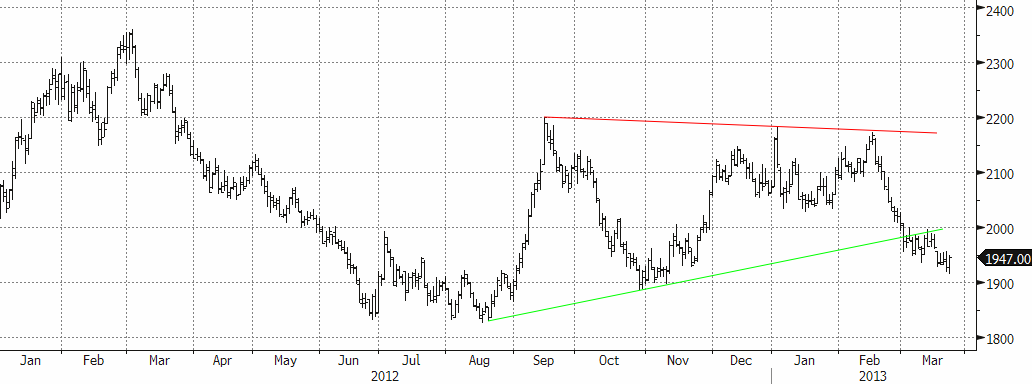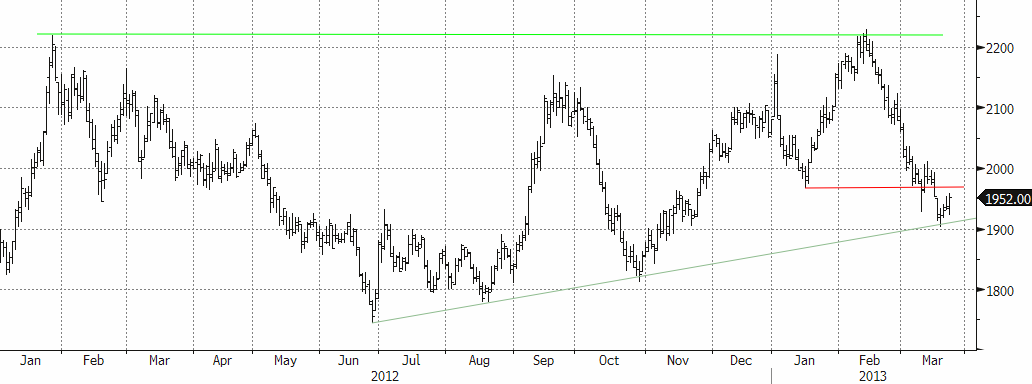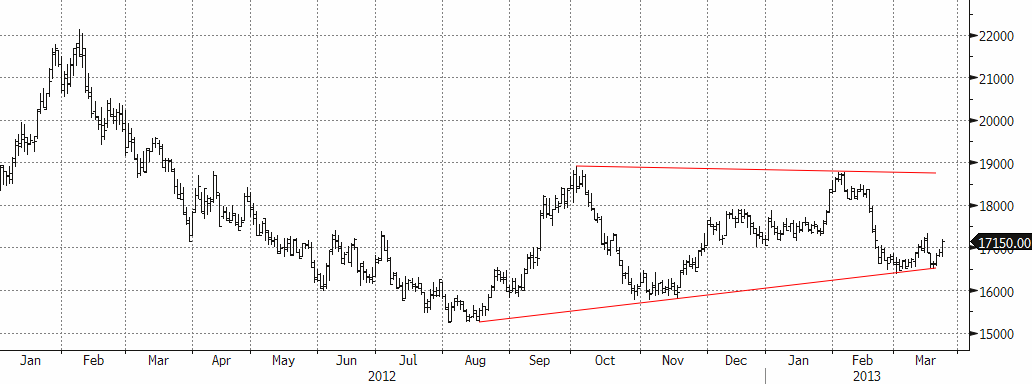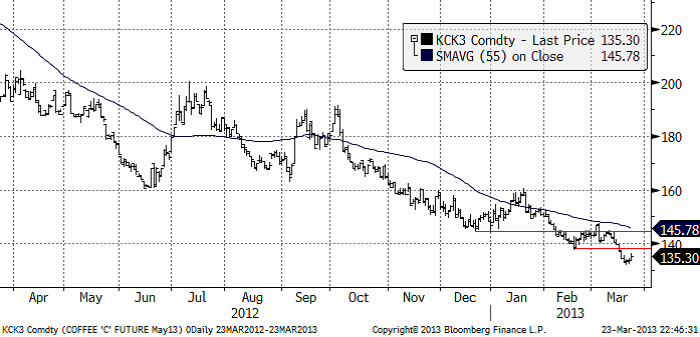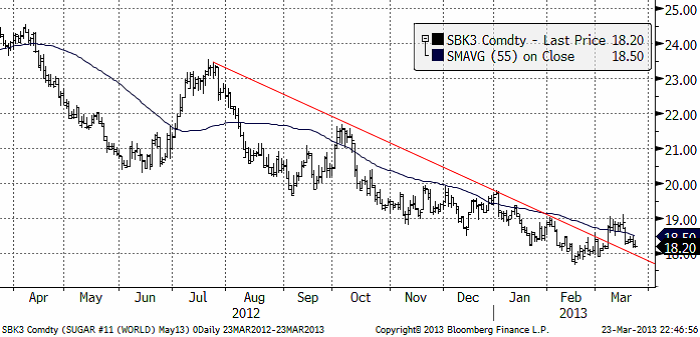Analys
SEB – Råvarukommentarer, 25 mars 2013

Rekommendationer
*) Avkastningen avser 1:1 råvarucertifikat där de ingår i rekommendationen. I den aktuella tabellen ovan har jag tagit prisförändringen den senaste veckan sedan det förra veckobrevet publicerades.
Inledning
VETE S med en uppgång sedan förra veckan på 4% tillhör en av veckans vinnare. Vår analys av WASDE-statstiken från det amerikanska jordbruksdepartementet för ett par veckor sedan, sade att prisfallet var över och att vi kunde vänta oss en rekyl uppåt. Det är precis vad som har hänt. Vi tror fortfarande att det handlar om en rekyl och rekommenderar därför inte en köpt position i vete eller majs.
EL S och NATGAS S har också stigit med 4%. Det är det kalla och torra vädret som gör att efterfrågan på värme stiger. I Norden visar det sig främst i EL S och i USA är det naturgasen som man kan handla via NATGAS S – certifikatet. Både el och amerikansk naturgas har fallit mycket i pris de senaste två åren och kan stå inför en längre uppgångsfas.
Råvaruindex
I diagrammet nedan ser vi SEB:s råvaruindex (svart) och DJUBS (röd). DJUBS innehåller mer jordbruksprodukter, som rekylerat uppåt den senaste tiden, vilket förklarar uppgången i det indexet. SEB:s råvaruindex innehåller förhållandevis mer petroleum (39%), som fallit i pris.
Den som vill investera i indexet och den investeringsstrategi som ligger bakom kan läsa mer om certifikatet RAVAROR S.
Råolja – Brent
Oljepriset har fortsatt att falla. Tekniskt ligger priset som vi ser ganska mitt i ett kursintervall mellan 105 och 110 dollar, som under förra året utgjorde en lägre nivå i det lite större intervallet 105 – 120 dollar. 105 dollar av allt att döma en viktig stödnivå.
Lagren och lagerförändringarna i USA per den 15 mars ser vi nedan, enligt Department of Energy och American Petroleum Institute.
Nedan ser vi amerikanska råoljelager enligt DOE i tusen fat. Den svarta kurvan är 2012 års lagernivåer vecka för vecka och den lilla röda linjen är 2013 års nivå. Vi ser att lagernivåerna fortsätter att vara högre än de varit sedan 2007 för den här tiden på året.
Lagren ökar samtidigt som vi ser att importen av råolja till USA fortsätter att minska. I veckans statistik minskade importtakten ytterligare.
Vi rekommenderar köp av OLJA S, men inte av BULL OLJA S. Anledningen till denna skillnad och att vi rekommenderar köp av OLJA S är för att rabatten på terminerna innebär en stadig intäkt om ca 6% till 7% per år + ränta på kapitalet. Nu när priset dessutom kommit ner mot den lägre delen av det etablerade prisintervallet 105 – 120 dollar är läget att köpa OLJA S särskilt bra.
Elektricitet
Priset på el gick genom motståndet vid 37.5 euro per MWh. Därmed bekräftades igen den positiva trenden. Vi går därför tillbaka till vår köprekommendation, något mer styrkta i vår tro på högre priser. Det förefaller som om botten på en den långa prisnedgången från vintern 2010/2011 har noterats. Vintern 2010/2011 handlades fast pris för ett kvartal på över 80 euro per MWh. Nedan ser vi den senaste kursutvecklingen i terminskontraktet för det tredje kvartalet.
Bakom den senaste veckans prisuppgång ligger en hausse-artad prisuppgång i utsläppsrätter för koldioxid. Trots svagheten i marknaden för energikol, fick detta kostnaden för att producera el med kolkraft att gå upp. Nedan ser vi kvatalskontraktet på Nordpool (euro/MWh) som den vita kurvan. Den röda kurvan är kostnaden för att producera 1 MWh timme med kol och utsläppsrätter.
Det är en kall och torr vår gör sommaren kort, skrev Lars Wivallius år 1642. Den hydrologiska balansen för NordPools börsområde har sjunkit ytterligare från -15.89 TWh till -18.68 TWh. I prognosen ligger den på -26 TWh. Det är en nivå där vattenkraften kan bli en av de dyrare energikällorna under det tredje kvartalet.
Sammanfattningsvis. Situationen har klarnat då priset snabbt bröt igenom motståndet på 37.5 euro / MWh. Bull-marknaden är bekräftad och vi rekommenderar en köpt position i elpriset. För normal risknivå väljer man EL S. Den som vill ta mer risk kan välja BULL EL X2 S och den som vill ta riktigt mycket risk och få fyra gångers hävstång på dagliga prisförändringar väljer BULL EL X4 S.
Naturgas
Det är kallt även i USA och naturgaspriset har påverkats av detta även där. Naturgasterminen på NYMEX (maj 2013) har handlats upp ordentligt och testar nu 4 dollar, där priset vänt ner två gånger tidigare. Vi fortsätter att hålla oss neutralt till naturgasen – men skulle ett brott ske av 4 dollar – är det en tydlig köpsignal. Vi ser kursdiagrammet nedan:
För lite mer perspektiv, ser vi kursutvecklingen på samma maj-kontrakt för de senaste fem åren nedan. Det ser onekligen ut som om något håller på att hända med priset – shale gas till trots!
Nedanför ser vi Within-day naturgaspris (spot) i Storbritannien. Priset är i pence per therm. The virtual gas hub operated by the TSO National Grid. Priset ligger nu på 100 pence. Detta beror på kylan där det väntas snö i England i helgen.
Vi erbjuder inte handel i små poster på den engelska naturgasmarknaden, men som vi ser är kylan just nu onormalt svår. Global temperatur håller dessutom på att bryta alla konfidensintervall nedåt från FN:s klimatpanels prognoser. De senaste årens energiproduktionsplanering som förutsatt varmare väder, kan, om temperaturen blir lägre leda till högre priser på marknaderna.
Guld och Silver
Jag tycker inte att priset på guld har handlats så starkt på Cypernkrisen som det skulle ha gjort för några år sedan, när uppåt-trenden i guldpriset var starkare. Guldmarknaden är betydligt svagare än vad man skulle kunna ha väntat sig. Jag misstänker att priset kommer att ha mycket lätt att falla om Cypernkrisen antingen glöms bort eller löses på något sätt. I det läget är det nog inte så bra att vara köpt guld.
Hela uppgångne de två senaste veckorna ser mer ut som en rekyl och det skulle inte förvåna om det kommer en prisnedgång i veckan. Priset är dock nere i ett intervall med botten kring 1500 – 1550 och en övre nivå på 1630. På lite längre sikt är detta kanske en nivå varifrån priset kommer att vända uppåt när de långsiktiga faktorerna får verka. På kort sikt ligger priset högt i det här intervallet.
Nedan ser vi kursdiagrammet för silver i dollar per troy ounce. Priset har fortsatt att röra sig sidledes och inte markerat samma uppgång på Cypernkrisen som guldet. Silver visar därmed större trendmässig svaghet än guldet. Vi fortsätter därför att vara köpta BEAR SILVER X2/X4 S.
Platina & Palladium
Platinapriset ligger strax över stödet på 1550 dollar, som testades – och höll – i veckan som gick. Om 1525 – 1550 byts på nedsidan är nästa stöd 1400.
Palladium rekylerade färdigt i veckan som gick och avslutade veckan med prisuppgångar.
Basmetaller
Veckan inleddes med beskedet om engångsskatten på Cypern som villkor för stödlånen, och påföljande försvagning av Euron. Det innebär starkare dollar, och svagare råvaror. Metallerna tog ordentligt med stryk inledningsvis, med ett par procent. Resten av veckan präglades till stor del av nyhetsflödet kring Cypern. Övrig makrodata kom därför lite i skymundan. Det har bl.a. redovisats preliminär inköpsindexdata som kom in starkare än väntat i både Kina och USA, men svagare i Europa. Temat kvarstår med positiva tecken i USA, Kina försiktigt positiv medan Europa är sänket. Netto för metallerna innebär detta en svag nedgång för koppar och aluminium. Zink är oförändrad på veckan medan nickel visar styrka med en uppgång på ett par procent.
Koppar
Priset har rört sig kraftigt i veckan. Efter den inledande ”Cypernfrossan” och en lägsta notering på $7500 för 3-månaders koppar på LME, såg vi nivåer på $7750 i mitten av veckan (med stöd av positiv inköpsstatistik från Kina). Veckan avslutas oförändrat till svagt nedåt. Prisskillnaden mellan inhemska priser i Kina och LME är nu till LME:s fördel. Baserat på historiska mönster brukar det innebära ökad Kinesisk import. De närmsta månaderna blir därför en ”test” på hur den inhemska konsumtionen ser ut. Skillnaden mot tidigare cykler är att LME-lagret (se nedan) har hunnit öka mer än vanligt. Så även om Kina ökar importtakten så dröjer det innan det blir brist utanför Kina.
LME-lager Koppar (Mton)
Den tekniska bilden ger stöd till vår neutrala position. Vi är positiva till basmetaller på sikt men avvaktar bättre köptillfällen alternativt väljer någon annan basmetall. Den stora triangelformationen börjar spela ut sin roll. Stödnivåer noteras vid 7600 och 7400. Nivån 7800 fungerar nu som motstånd.
Som vi skrivit tidigare tyder mycket på ökat utbud för koppar, vilket ökar risken för en lite trögare marknad. Vi ser inte den stora potentialen på koppar på uppsidan just nu. Vi rekommenderar därför en fortsatt neutral position. För den som vill satsa på ett starkare tillväxtscenario (än konsensus) i Kina är koppar däremot alltid ett intressant alternativ.
Aluminium
Som vi skrivit tidigare ligger aluminium väldigt ”fast” i ett relativt stort handelsintervall. Nivåer kring $1800-1900 utgör ur ett kostnadsperspektiv starkt stöd. Samtidigt lägger det stora utbudet ett ”tak” på nivåer kring $2300. Den senaste uppgången i februari mötte stora säljordrar från producenter som passade på att ”låsa” framtida priser, vilket satte press på marknaden. Nu när priserna fallit tillbaka ser vi stora intressen från köpsidan (fysiska förbrukare). För den ”trading-benägne” utgör det stora spannet goda vinstmöjligheter.
P.g.a. den låga prisnivån i relation till marginalkostnaden är aluminium köpvärd och vi ansluter den till köprekommendationerna.
Zink
Under veckans inledning (i samband med nyhetsflödet kring Cypern) bröts även stödnivån $1975. Som lägst handlades nivåer i närheten av den starka stöd linjen, som kommer in strax över $1900. Det ”gamla” stödet utgör ett nu istället ett motstånd om det prövas underifrån. Tekniskt sett bör man avvakta lite för att se om trendlinjen håller, och bryter 1975 igen så är det ett köp. Fundamentalt är zinken ”billig” ur ett kostnadsperspektiv och nuvarande nivåer är intressanta på lite längre sikt (12 månader).
Nickel
Efter den stora tillbakagången ser vi en tydlig stabilisering av priset. Ur ett kostnadsperspektiv börjar nickel bli en väldigt intressant köpkandidat. Marknaden är fortsatt tveksam till den fundamentala situationen. Vi har tidigare bl.a. hänvisat till kommentarer från fysiska aktörer som indikerar att ”det finns gott om nickel”, samtidigt som rapporter gör gällande att exporten av nickelmalm från Indonesien till Kina ökar igen, vilket riskerar att öka utbudet av s.k. Nickel Pig Iron i Kina (vilket i sin tur minskar efterfrågan på nickelbärande skrot och primärnickel). Det senare håller nu på att ”svänga om” då kinesiska producenter är snabba att ställa om produktionen. Det ger ett naturligt stöd till nickelmarknaden. Veckans utveckling kan dock mana till viss försiktighet. Förra veckans toppar kring $17300 kommer att utgöra motstånd. För den som vill komma in i marknaden kan det vara värt att avvakta, och antingen köpa kring stödet vid $16500 alternativt vid ett brott av $17300.
Vi rekommenderar köp av NICKEL S eller BULL NICKEL X2 / X4 S för den som vill ta mer risk. Vi varnade för en rekyl, och den kom. Priset har fallit mer än ”befarat”, men är nu på väldigt attraktiva nivåer.
Kaffe
Kaffepriset (maj 2013) fortsatte ner i veckan som gick och fortsatte därmed den fallande trenden.
CEPEA rapporterar från Brasilien att det fortfarande finns gott om arabica av 2012/2013 års skörd kvar. En undersökning gjord av CEPEA visar att mellan 30% och 40% av skörden fortfarande finns i lager på gårdarna. I Espirito Santo, där Robusta odlas, finns 20% kvar. Robusta har den senaste säsongen varit ovanligt ”dyrt” i förhållande till arabica. Bönderna har utnyttjat detta genom att sälja mer av Robusta. Efterfrågan på arabica har också haft fokus på de sämre kvaliteterna. Därför är det till största delen arabica av god kvalitet som finns kvar osålt på gårdarna. Försäljningstakten sedan oktober har varit lägre än tidigare år. I Cerrado-regionen av Minas Gerais har bara 10% sålts. Cerrado är ett område som producerar förstklassigt kaffe.
Förra veckan gick vi över till neutral rekommendation från köp. Fortfarande väntar vi på tydligare tecken på att en botten etablerats. Kaffepriset är lågt och kommer säkerligen att vara högre om ett år eller två, men det är onödigt att köpa för tidigt.
Socker
Sockerpriset (maj 2013) som inte lyckades ta sig över 19 cent, har fortsatt att falla i pris. Trendlinjen från pristoppen i juli förra året är dock bruten, vilket är ett positivt tecken. Vi ser prisfallet nu som en rekyl nedåt, snarare än ett återfall in i den fallande pristrenden.
Den brasilianska regeringen har sänkt skatterna på matvaror i landet, bland annat på socker. Enligt CEPEA är det nu marginellt mer lönsamt att producera socker än etanol.
Vi tror att en trendvändning kan vara på gång. I februari fann marknaden stöd vid och strax under 18 cent (på majkontraktet). Det ser ut som om marknaden vill testa den nivån igen. Håller den – och priset vänder upp därifrån – ökar sannolikheten för en trendvändning uppåt.
[box]SEB Veckobrev Veckans råvarukommentar är producerat av SEB Merchant Banking och publiceras i samarbete och med tillstånd på Råvarumarknaden.se[/box]
Disclaimer
The information in this document has been compiled by SEB Merchant Banking, a division within Skandinaviska Enskilda Banken AB (publ) (“SEB”).
Opinions contained in this report represent the bank’s present opinion only and are subject to change without notice. All information contained in this report has been compiled in good faith from sources believed to be reliable. However, no representation or warranty, expressed or implied, is made with respect to the completeness or accuracy of its contents and the information is not to be relied upon as authoritative. Anyone considering taking actions based upon the content of this document is urged to base his or her investment decisions upon such investigations as he or she deems necessary. This document is being provided as information only, and no specific actions are being solicited as a result of it; to the extent permitted by law, no liability whatsoever is accepted for any direct or consequential loss arising from use of this document or its contents.
About SEB
SEB is a public company incorporated in Stockholm, Sweden, with limited liability. It is a participant at major Nordic and other European Regulated Markets and Multilateral Trading Facilities (as well as some non-European equivalent markets) for trading in financial instruments, such as markets operated by NASDAQ OMX, NYSE Euronext, London Stock Exchange, Deutsche Börse, Swiss Exchanges, Turquoise and Chi-X. SEB is authorized and regulated by Finansinspektionen in Sweden; it is authorized and subject to limited regulation by the Financial Services Authority for the conduct of designated investment business in the UK, and is subject to the provisions of relevant regulators in all other jurisdictions where SEB conducts operations. SEB Merchant Banking. All rights reserved.
Analys
Tightening fundamentals – bullish inventories from DOE

The latest weekly report from the US DOE showed a substantial drawdown across key petroleum categories, adding more upside potential to the fundamental picture.

Commercial crude inventories (excl. SPR) fell by 5.8 million barrels, bringing total inventories down to 415.1 million barrels. Now sitting 11% below the five-year seasonal norm and placed in the lowest 2015-2022 range (see picture below).
Product inventories also tightened further last week. Gasoline inventories declined by 2.1 million barrels, with reductions seen in both finished gasoline and blending components. Current gasoline levels are about 3% below the five-year average for this time of year.
Among products, the most notable move came in diesel, where inventories dropped by almost 4.1 million barrels, deepening the deficit to around 20% below seasonal norms – continuing to underscore the persistent supply tightness in diesel markets.
The only area of inventory growth was in propane/propylene, which posted a significant 5.1-million-barrel build and now stands 9% above the five-year average.
Total commercial petroleum inventories (crude plus refined products) declined by 4.2 million barrels on the week, reinforcing the overall tightening of US crude and products.


Analys
Bombs to ”ceasefire” in hours – Brent below $70

A classic case of “buy the rumor, sell the news” played out in oil markets, as Brent crude has dropped sharply – down nearly USD 10 per barrel since yesterday evening – following Iran’s retaliatory strike on a U.S. air base in Qatar. The immediate reaction was: “That was it?” The strike followed a carefully calibrated, non-escalatory playbook, avoiding direct threats to energy infrastructure or disruption of shipping through the Strait of Hormuz – thus calming worst-case fears.

After Monday morning’s sharp spike to USD 81.4 per barrel, triggered by the U.S. bombing of Iranian nuclear facilities, oil prices drifted sideways in anticipation of a potential Iranian response. That response came with advance warning and caused limited physical damage. Early this morning, both the U.S. President and Iranian state media announced a ceasefire, effectively placing a lid on the immediate conflict risk – at least for now.
As a result, Brent crude has now fallen by a total of USD 12 from Monday’s peak, currently trading around USD 69 per barrel.
Looking beyond geopolitics, the market will now shift its focus to the upcoming OPEC+ meeting in early July. Saudi Arabia’s decision to increase output earlier this year – despite falling prices – has drawn renewed attention considering recent developments. Some suggest this was a response to U.S. pressure to offset potential Iranian supply losses.
However, consensus is that the move was driven more by internal OPEC+ dynamics. After years of curbing production to support prices, Riyadh had grown frustrated with quota-busting by several members (notably Kazakhstan). With Saudi Arabia cutting up to 2 million barrels per day – roughly 2% of global supply – returns were diminishing, and the risk of losing market share was rising. The production increase is widely seen as an effort to reassert leadership and restore discipline within the group.
That said, the FT recently stated that, the Saudis remain wary of past missteps. In 2018, Riyadh ramped up output at Trump’s request ahead of Iran sanctions, only to see prices collapse when the U.S. granted broad waivers – triggering oversupply. Officials have reportedly made it clear they don’t intend to repeat that mistake.
The recent visit by President Trump to Saudi Arabia, which included agreements on AI, defense, and nuclear cooperation, suggests a broader strategic alignment. This has fueled speculation about a quiet “pump-for-politics” deal behind recent production moves.
Looking ahead, oil prices have now retraced the entire rally sparked by the June 13 Israel–Iran escalation. This retreat provides more political and policy space for both the U.S. and Saudi Arabia. Specifically, it makes it easier for Riyadh to scale back its three recent production hikes of 411,000 barrels each, potentially returning to more moderate increases of 137,000 barrels for August and September.
In short: with no major loss of Iranian supply to the market, OPEC+ – led by Saudi Arabia – no longer needs to compensate for a disruption that hasn’t materialized, especially not to please the U.S. at the cost of its own market strategy. As the Saudis themselves have signaled, they are unlikely to repeat previous mistakes.
Conclusion: With Brent now in the high USD 60s, buying oil looks fundamentally justified. The geopolitical premium has deflated, but tensions between Israel and Iran remain unresolved – and the risk of missteps and renewed escalation still lingers. In fact, even this morning, reports have emerged of renewed missile fire despite the declared “truce.” The path forward may be calmer – but it is far from stable.
Analys
A muted price reaction. Market looks relaxed, but it is still on edge waiting for what Iran will do

Brent crossed the 80-line this morning but quickly fell back assigning limited probability for Iran choosing to close the Strait of Hormuz. Brent traded in a range of USD 70.56 – 79.04/b last week as the market fluctuated between ”Iran wants a deal” and ”US is about to attack Iran”. At the end of the week though, Donald Trump managed to convince markets (and probably also Iran) that he would make a decision within two weeks. I.e. no imminent attack. Previously when when he has talked about ”making a decision within two weeks” he has often ended up doing nothing in the end. The oil market relaxed as a result and the week ended at USD 77.01/b which is just USD 6/b above the year to date average of USD 71/b.

Brent jumped to USD 81.4/b this morning, the highest since mid-January, but then quickly fell back to a current price of USD 78.2/b which is only up 1.5% versus the close on Friday. As such the market is pricing a fairly low probability that Iran will actually close the Strait of Hormuz. Probably because it will hurt Iranian oil exports as well as the global oil market.
It was however all smoke and mirrors. Deception. The US attacked Iran on Saturday. The attack involved 125 warplanes, submarines and surface warships and 14 bunker buster bombs were dropped on Iranian nuclear sites including Fordow, Natanz and Isfahan. In response the Iranian Parliament voted in support of closing the Strait of Hormuz where some 17 mb of crude and products is transported to the global market every day plus significant volumes of LNG. This is however merely an advise to the Supreme leader Ayatollah Ali Khamenei and the Supreme National Security Council which sits with the final and actual decision.
No supply of oil is lost yet. It is about the risk of Iran closing the Strait of Hormuz or not. So far not a single drop of oil supply has been lost to the global market. The price at the moment is all about the assessed risk of loss of supply. Will Iran choose to choke of the Strait of Hormuz or not? That is the big question. It would be painful for US consumers, for Donald Trump’s voter base, for the global economy but also for Iran and its population which relies on oil exports and income from selling oil out of that Strait as well. As such it is not a no-brainer choice for Iran to close the Strait for oil exports. And looking at the il price this morning it is clear that the oil market doesn’t assign a very high probability of it happening. It is however probably well within the capability of Iran to close the Strait off with rockets, mines, air-drones and possibly sea-drones. Just look at how Ukraine has been able to control and damage the Russian Black Sea fleet.
What to do about the highly enriched uranium which has gone missing? While the US and Israel can celebrate their destruction of Iranian nuclear facilities they are also scratching their heads over what to do with the lost Iranian nuclear material. Iran had 408 kg of highly enriched uranium (IAEA). Almost weapons grade. Enough for some 10 nuclear warheads. It seems to have been transported out of Fordow before the attack this weekend.
The market is still on edge. USD 80-something/b seems sensible while we wait. The oil market reaction to this weekend’s events is very muted so far. The market is still on edge awaiting what Iran will do. Because Iran will do something. But what and when? An oil price of 80-something seems like a sensible level until something do happen.
-

 Nyheter3 veckor sedan
Nyheter3 veckor sedanStor uppsida i Lappland Guldprospekterings aktie enligt analys
-

 Nyheter4 veckor sedan
Nyheter4 veckor sedanBrookfield ska bygga ett AI-datacenter på hela 750 MW i Strängnäs
-

 Nyheter4 veckor sedan
Nyheter4 veckor sedanSommaren inleds med sol och varierande elpriser
-

 Nyheter4 veckor sedan
Nyheter4 veckor sedanOPEC+ ökar oljeproduktionen trots fallande priser
-

 Nyheter3 veckor sedan
Nyheter3 veckor sedanSilverpriset släpar efter guldets utveckling, har mer uppsida
-

 Analys4 veckor sedan
Analys4 veckor sedanBrent needs to fall to USD 58/b to make cheating unprofitable for Kazakhstan
-

 Nyheter4 veckor sedan
Nyheter4 veckor sedanTradingfirman XTX Markets bygger datacenter i finska Kajana för 1 miljard euro
-

 Nyheter2 veckor sedan
Nyheter2 veckor sedanUppgången i oljepriset planade ut under helgen


